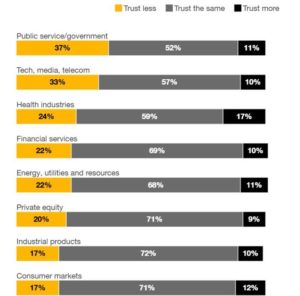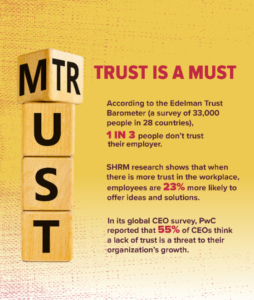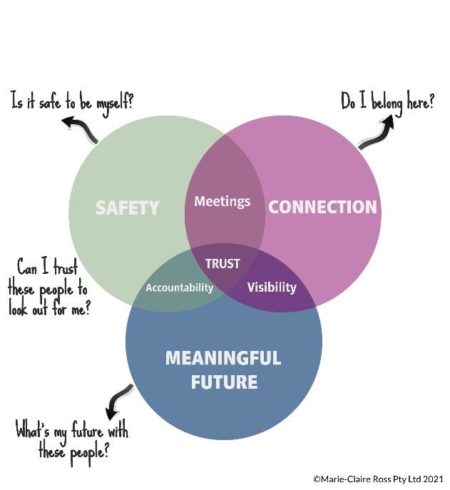
December 21, 2022
In the digital world,
trust is the new digital currency of success

How much trust do your customers, employees, supply chain partners, and other key stakeholders have in your company?
One of the major changes that came out of the Covid-19 pandemic was the increasing trust gap between individuals and institutions. Whether it was employees at Starbucks, Google, Twitter, and Amazon challenging the legitimacy of their companies’ business motives, or an increasing lack of faith in critical institutions like the CDC and the Supreme Court, the bonds of trust were frayed if not broken.
Statistics from a recent PwC study amplify this gap disparity as 87% of business executives thought consumers had a high level of trust but only 30% said they did. The chart below illustrates that across all industries the loss of trust is significantly higher than the increase in trust.

47% of senior executives said trust is developed from the bottom-up not the top-down by consumers, employees, and other stakeholders however only 27% of consumers and 35% of employees agreed, believing the C-Suite should lead on building trust.
This begs the question, what do companies need to do to rebuild trust and clearly demonstrate their commitment to keeping their promises?
Collaborating with your customers instead of marketing at them is a good place to start

Traditional marketing is primarily about stimulating product or service trial. In the digital world, trial is replaced by what a customer or prospect can learn on their own about your product or service and the trust they have in their friends’ experience with it.
To successfully compete and grow your business in this environment, you need to start with the outcome the customer wants to achieve and build a collaborative process to deliver that outcome. When the customer is a direct participant in the development of the product or service, they have a much higher level of trust in the ultimate solution.
Recent surveys have shown that the stakes are high.
- A 2018 global survey from digital experience firm Acquina found that while 87% of brand marketers believe they are delivering great customer experiences, less than half of customers agree.
- A US survey from Oracle notes that 43% of consumers will blacklist a brand as a result of a bad experience. A further 34% say they will never shop with a company again after just one poor experience.
- An SAP study showed that 72% of customers will share a positive experience with six or more people.
- According to an Epsilon study, 80% of consumers are more likely to do business with a company that offers them personalized experiences based on their expressed desire for them.
Shifting from a transaction-centric to a relationship-centric customer engagement model

Transaction-centric customer engagement models create a lopsided exchange of value between the provider and the consumer. They are based on the provider’s belief that what they have to offer is more important than the experience of how they offer it. Increasingly, individuals and businesses are making buying decisions based on their emotional connection to the company and its desire to create a shared value experience.
As Paul Robson, President of International at Adobe says, “It is no longer a case of just creating experiences for customers; the future of e-commerce hinges on creating experiences with customers to establish ongoing relationships, and ultimately earn trust and loyalty.”
According to Adobe’s latest research, more that 90% of marketers rated their company good or excellent at delivering personalized customer experiences at scale. However, only 33% of consumers felt brands had improved personalization in the last 12 months. To close this enormous gap, companies need to leverage systems of intelligence to better measure, understand, and thereby anticipate the actual personalized experiences consumers are looking for.
To achieve that result, CMOs, CIOs, and other C-suite leaders need to work together to transform their thinking about the critical need to deliver emotionally rewarding experiences and redefine their customer engagement strategy accordingly.
Employee trust is essential for sustainable competitive success

Gallup research has documented the significant impact and value employee trust has on a company’s performance:
- Companies with high trust levels outperform companies with low trust levels by 186%
- 96% of engaged employees trust management compared to 46% of disengaged employees
- Highly trusted workplaces enjoy 50% higher employee productivity, 106% more energy at work, and 13% fewer sick days
- Employees who trust their employers experience 74% less stress
- 33% of employees would stay longer if the company kept its promises
Companies with high levels of fully engaged employees have realized a 65% increase in their customer satisfaction scores as the chart below illustrates.

Building a culture of trust is now mission critical
In its essence, trust is the belief employees feel when their workplaces are safe and their co-workers are looking out for their best interests. Many have called this “psychological safety.” According to Google, “psychological safety is by far the most important out of all the dynamics they measured in high-performance teams.”
To build trust across any organization requires a clear definition of individual and team roles and responsibilities, along with specific decision-making governance policies that foster innovation and experimentation without fear of failure. It also requires aligning individual tasks. Here are some characteristics of leaders who I have observed create a culture of trust:
- They know the right balance between dealing with current developments and getting out in front of future developments.
- They seize the narrative at the outset, being very clear about what is known, what is not known, and what needs to be done to learn more.
- They recognize that a crisis ruled by unfamiliarity and uncertainty requires decisions and responses that are largely improvised.
- They promote an environment of “psychological safety” that allows people to openly discuss ideas, questions, and concerns without fear of repercussions.
- They distribute decision making authority and information sharing.
- They mobilize their organizations by setting clear priorities and empowering others to discover and implement solutions to achieve those priorities.
- They unify cross-functional teams behind mission critical outcomes and realign incentives for them to achieve those outcomes.
- They understand that “competence precedes comprehension” which puts a bias on taking action and iterative learning to make necessary adjustments in real time.
- They act with resolve and visible decisiveness.
- They know that their ultimate goal is to “make a positive difference in people’s lives.”
As always, I am interested in your comments, feedback and perspectives on the ideas put forth in this blog. Please e-mail them to me on linkedin. And, if this content could be useful to someone you know please share it here:




